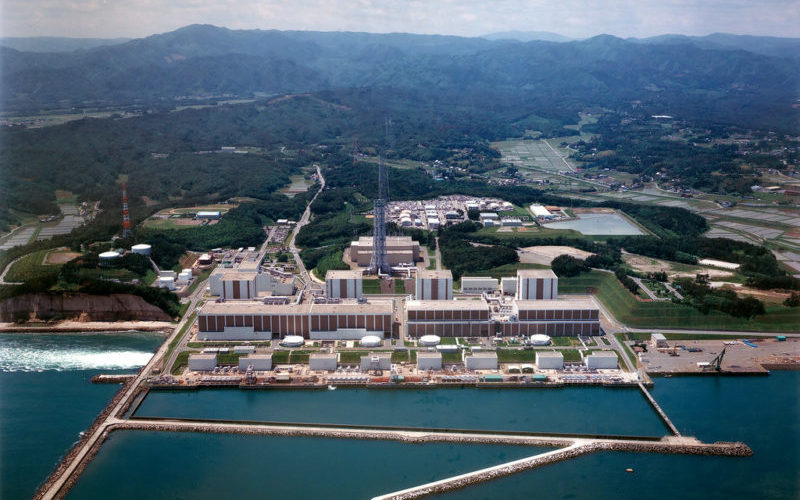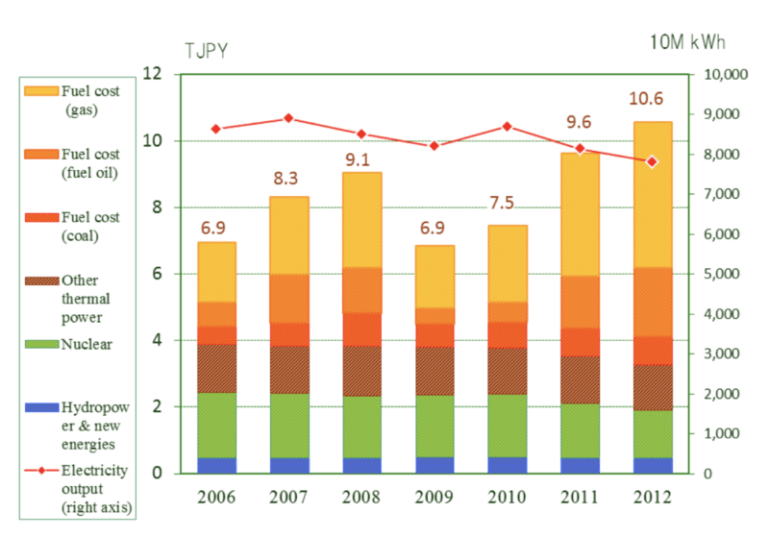
Energy security in Japan
Japan relied heavily on imports of fossil fuels while recovering from WWII. This vulnerability became critical in the wake of the 1973 oil crisis and led to diversification in Japan’s energy mix towards a significant use of nuclear energy.
This trend was sustained during the following decades and even increased at the beginning of the 21st century due to environmental concerns. For example, in 2008, the Ministry of Economy, Trade and Industry (METI) set the goal of reducing CO2 emissions by 54 per cent by 2050, and 90 per cent by 2100. This would lead to nuclear power contributing around 60 per cent of primary energy consumption by 2100 and being responsible for 51 per cent of emission reduction.
However, in July 2011, after the Fukushima accident, the Japanese government decided to shut down all its nuclear power plants. As a consequence by February 2012, electricity costs increased by 15 per cent.
 Figure: The trend of Power Generation Costs (Total for 12 Companies)
Figure: The trend of Power Generation Costs (Total for 12 Companies)
The cut in nuclear plants affected Japan’s trade balance. Between 2011 and 2013, the cost of importing energy resources into Japan was $40 trillion, and the total trade deficit between April 2011 and March 2014 was $227 billion. As a result, the government was forced to adopt the 4th Strategic Energy Plan in 2014 and declare that nuclear energy was a vital energy source that would continue being used under optimal security conditions to achieve a stable and affordable energy supply.
So, energy security is Japan’s main geopolitical concerns. As an island nation without indigenous energy sources, Japan relies heavily on imported fossil fuels. This overreliance on imports endangers the country’s energy system if a geopolitical event disrupts shipping to East Asia. The most likely disruptive events being a war between the United States and Iran, an open conflict with China over the Senkaku islands, or an attack (conventional or nuclear) from North Korea.
Japan’s energy future and the problem of public opinion
However, the most severe challenge facing policy-makers and the nuclear industry in Japan is the loss of public confidence in this type of energy. For instance, the 2015 Japan Atomic Energy Relations Organization (JAERO) survey found that 47.9 per cent of respondents want nuclear power abolished gradually. 14.8 per cent think it should be halted immediately. Only 10.1 per cent said that the use of atomic energy should be maintained and 1.7 per cent said it should increase.
These opinions have a bigger eco in the countryside where mayors or prefecture’s chief have informal veto power on the reopening of nuclear power plants, which at the same times is highly conditioned by electoral dynamics and popular support.
In 2013, Abe’s government created the Nuclear Regulation Authority (NRA), an agency with an independent decision-making authority based on scientific and technological data, to develop new safety standards and boost public confidence for the nuclear reactors reopening process.
However, faith in nuclear energy has not been restored. According to a more recentJAERO study, the ratio of the public who trust the nuclear industry is 1.2 per cent, and those who do not is 22.0 per cent. The reasons for these figures are the lack of information disclosure, insufficient preparation and management on safety, and the perceived lack of honesty from industrials and public officials.
The problem of nuclear waste
The Japanese government must also find safe ways to manage stocks of irradiated nuclear fuel. By the end of 2016, Japan had 14,000 tons of spent nuclear fuel stored in nuclear power plants, filling about 70 per cent of its on-site storage capacity. The law requires reprocessing of spent fuel to recover its plutonium and uranium content. But fuel storage in Rokkasho, Japan’s only commercial reprocessing plant, is nearly full, causing potential risks derived from the lack of storage space, such as the need to stop uranium reprocessing or halting nuclear power plants activity increasing like that Japan’s energy vulnerability.
Other risks derived from excessive storage and conservation conditions can be leaks of irradiated particles, which represent a threat to public health. That’s why the construction of an interim storage facility in Mutsu is planned, however, in the medium term this problem will force Japan to move spent fuel to dry cask storage, and in the long term, it will need to increase this capacity and find a candidate site for final disposal of spent fuel.
Japan also has nearly 48 tons of separated plutonium. Just one tone of separated plutonium is enough material to manufacture more than 120 nuclear weapons. Many countries have expressed concern about Japan’s plans to store plutonium and use it as nuclear fuel. Some, such as China, fear that Japan may use the material to produce nuclear weapons rapidly. Consequently, maintaining this policy could increase security concerns and regional tensions, and could stimulate an arms race in East Asia.
The geopolitics of nuclear energy
Although only nine of Japan’s 38 commercial reactors are currently functioning, the government and the nuclear industry hope to be able to solve much of the problems associated with this sector by exporting energy and infrastructures to foreign markets. For the Japanese government, this is a critical component of its program to boost economic growth, and for the Japanese nuclear industry, this is the last hope to do business after Fukushima.
Companies like Toshiba, Hitachi and Mitsubishi, entered foreign markets with the help and support of the Japanese government. Japan’s public-private partnership to build nuclear power plants is a lucrative opportunity that could position Japan as one of the world’s leading energy suppliers in the future. After all, nuclear power is in demand in countries such as Turkey, Poland, Bangladesh, Pakistan and Argentina, that are eager to reduce CO2 emissions and increase their energy security.
At the same time, demand for reactors appears to be stable worldwide. In particular, China and Russia have been vigorously entering foreign markets in recent years through their state-owned companies. For example, Rosatom announced last year that it had acquired contracts to build 35 new reactors, 67 per cent of the world total. Chinese and Russian state-owned companies have been supplying nuclear material at lower costs than Japanese and Western ones, which has pushed up fossil fuel prices and raised national security concerns in many countries. This is why in 2017 a memorandum of understanding was signed between Japan and the United States to promote the global leadership role of both countries in the field of civil nuclear energy to counter Chinese and Russian dominance of the global nuclear energy market.
General assessment and foresight
Since Fukushima, the reopening of nuclear power plants in Japan has become more difficult in many ways. The Japanese government has adopted much stricter safety measures, and the nuclear industry has had to fight tirelessly to regain the confidence of the Japanese people.
In the coming years, the public acceptance of nuclear energy among Japanese local and regional leaders will be highly likely for environmental and employment reasons. However, the process of recovering Japan’s public support for nuclear energy is expected to take several years. The Nuclear Regulation Authority appears to be a credible and effective voice for public acceptance of the reopening of nuclear power plants. However, it is essential that this agency maintains its role as an impartial, fact-based entity to maintain its credibility with opponents of nuclear energy.
On the other hand, Japan will need to make significant strategic efforts to develop alternative energy sources. To bring its energy self-sufficiency rate back to the 2010 level or even higher, an optimal combination of renewable and nuclear energy is imperative.